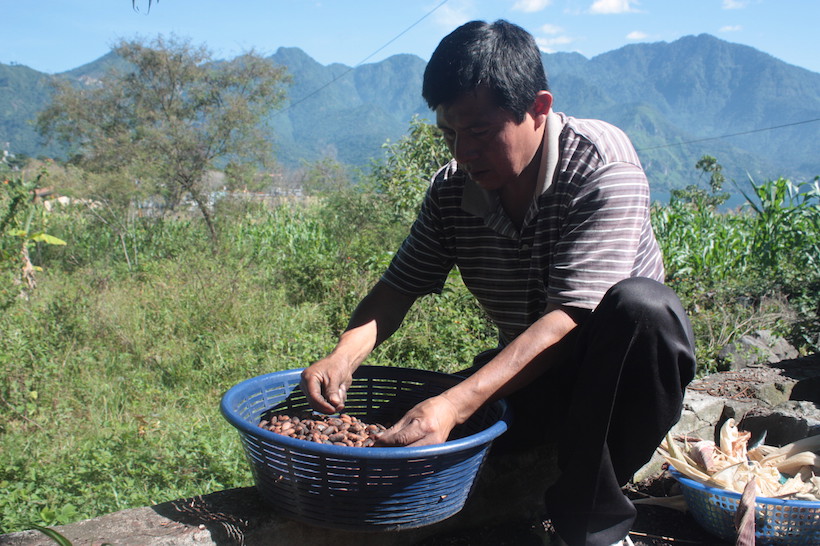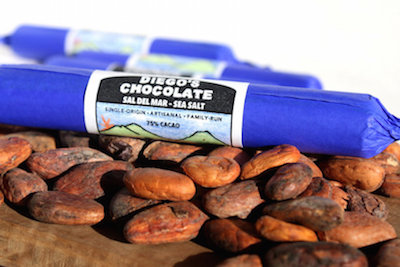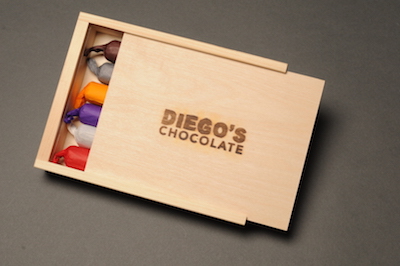When it comes to chocolate, everyone’s an expert. But when was the last time you experienced small batch, handcrafted chocolate cultivated with the kind of attention typically reserved for endeavors like neurosurgery and tightrope walking?
Been a while, right? Diego’s Artisan Chocolate will change that. Meet Diego Efrain Hernandez Cumes, a Guatemalan chocolate maker who produces only “Mayan-made, Mayan-grown” products and adheres to a strict bean to bar mentality.
We asked Diego about his chocolate, including its inspiration, creation, traditions, and more. Here’s what he had to say. [pagebreak]
The Latin Kitchen: We’ve read a little about your family’s roots in Guatemala. Can you expand on your culture and the MayaTz’utujil people?
Here in San Pedro la Laguna, the indigenous culture of the Tz ́utujil people is still very strong. Most people continue the old ways of the “campesino,” cultivating corn, coffee, and beans. This work is well respected. While our population is Christian, many still practice the ancient Mayan ceremonies. Our women wear the traditional “traje” including the famous “huipil” (blouse), handmade on back strap looms like our grandmothers and great grandmothers did. Also, the majority of the population here speaks the Tz’utujil language with pride. In other parts of the country, the indigenous languages and customs are slowly fading away, but here it is all very strong.
What can you tell us about your grandmother’s authentic chocolate recipe?
In my grandparents’ day, they made a rustic chocolate made of toasted cacao and corn, which was ground into a mixture for drinking. My grandmother told me that her mother taught her the recipe, and that it goes back deep into our family history. Although Diego’s Chocolate is meant for eating rather than drinking, it reminds us of the connection we share with the past and with our ancestors. I am now teaching my sons how to make chocolate and some day they and my grandchildren will carry on the tradition. This way, I hope, our chocolate never dies.
How is your process of making chocolate different from others’ methods?
Well, the biggest difference is that our chocolate is based upon panela, rather than white sugar. Panela is basically the pure juice from sugar cane, evaporated and then dehydrated into blocks of about 1kg. It is a very natural sweetener – one that is used commonly all over Central America. I like to use panela because of the rich taste and the fact that it is only minimally processed, unlike white sugar. Also, the panela is “cooked” with a little orange juice in order to liquefy it and mix it with the chocolate. I don’t know of any other chocolate makers who are currently doing this. Oh, and don’t forget the tubular shape of our chocolate – it’s unlike any other! [pagebreak]
What does the process look like, from start to finish?
First, we buy our cacao directly from small farmers who tend to their cacao trees and other plantings. Since we are a small, familyrun business, we prefer to support others who are like us. This is why I buy directly from farmers without intermediaries. I have been told this is known in the USA as “direct trade.” About the process: the cacao is first roasted over a wood fire, slowly and carefully. After that every bean is shelled by hand. This work is slow, but it allows us to pick out the beans that aren’t the best. After being roasted and shelled, the beans are brought to the mill where it is ground up into a thick liquid. We mix that with the cooked panela and orange juice mixture. This becomes our “puro” (vegan) chocolate. From there we may add milk and whatever flavorings the order calls for. Later, we roll the chocolate into little tubes by hand and package them up.
Speaking of the packaging, how did you come up with the chocolate’s beautiful shape and design?
When I started making chocolate, I spent a lot of time looking at the packaging of other companies. From doing this I decided that I didn’t want to copy anyone else’s designs. I should come up with something new. That’s how I got the idea of changing the shape into the tube form. Regarding the packaging, on the label you will see the three volcanoes that surround our home, Lake Atitlan. We live at the base of San Pedro Volcano – and we are proud to showcase this. The lake and its mountains are very famous in Central America and indeed around the world. Since our chocolate is rooted in culture, tradition and location, I wanted our product to show people where we are. The labels are also colored by hand which gives muchneeded work to our employees. Guatemala is a very colorful country and with that I got the idea to have a different colored wrapper for each color. We know for sure that people really love our packaging – we get comments on it all the time! However, we are working on fine-tuning a few things about it. You may see some changes in the near future. [pagebreak]
What about the various flavors? Which are most popular?
Well, the flavors represent different agricultural products that can be found here in Guatemala. I try to have something for everyone’s taste. The most popular flavors are Spicy, Sea Salt, Cardamom, Puro, and Raisins. My personal favorite is the Raisin flavor. Dark chocolate and raisins go together really nicely.
You seem to also take pride in your vegan chocolate option. How did this come about?
I know that there are a lot of people out there who don’t consume milk or other animal products. While I don’t personally follow that diet, I respect it and want to have chocolate that anyone can eat. Lately, we have been getting requests for more vegan flavors and are currently working on figuring out the best combinations.
How important is it to you to keep your product authentic and rooted in tradition?
This is very important to me. Chocolate is life for our family and I hope this continues long after I am gone. Making chocolate is a way of paying homage to our ancestors as well as a means to make a living, of course. As our business grows, we will be sure to keep it rooted in tradition, in our indigenous Mayan way, so that future generations can learn and understand what the work is that we do, and why we love it so much.




![Making Mealtime Matter with La Familia: Easy Sofrito [Video]](https://thelatinkitchen.com/wp-content/uploads/2015/10/sofrito-shutterstock__0-500x383.jpg)
![Easy Latin Smoothies: Goji Berry Smoothie [Video]](https://thelatinkitchen.com/wp-content/uploads/2015/12/goji_berry-shutterstock_-500x383.jpg)
















![Fun and Fast Recipes: Fiesta Cabbage Salad [Video]](https://thelatinkitchen.com/wp-content/uploads/2015/11/fiesta_cabbage_slaw-shutterstock_-500x383.jpg)









